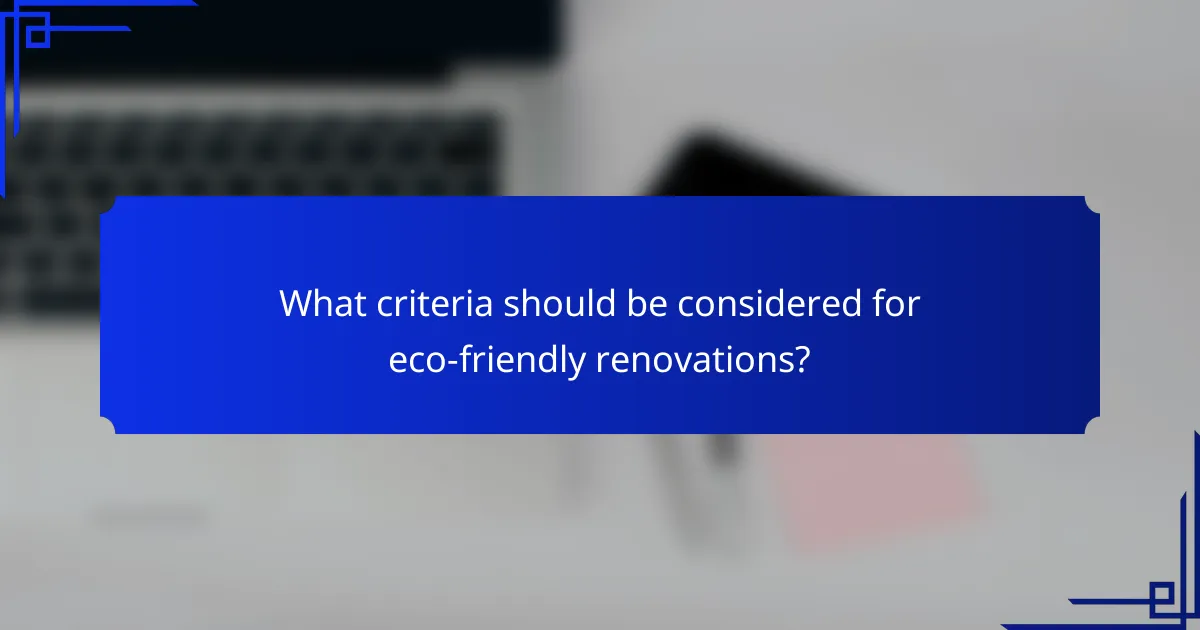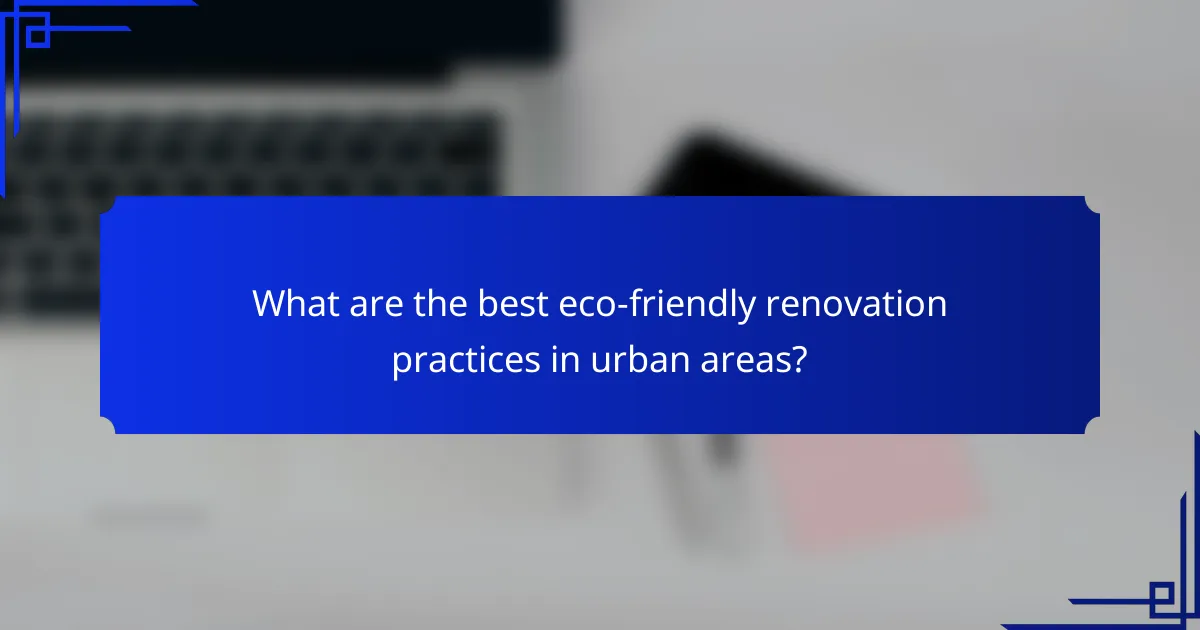Eco-friendly renovations provide a multitude of benefits, including substantial cost savings through reduced utility expenses and potential tax incentives. By focusing on sustainable materials and technologies, these renovations not only lower energy consumption but also promote better indoor air quality and overall health. Additionally, investing in eco-friendly upgrades can enhance the resale value of your home, making it a smart choice for both your wallet and the environment.

How can eco-friendly renovations save costs in major US cities?
Eco-friendly renovations can significantly reduce costs in major US cities by lowering utility expenses, qualifying for tax incentives, and decreasing maintenance needs. These savings not only enhance financial efficiency but also contribute to a healthier living environment.
Lower utility bills
One of the most immediate benefits of eco-friendly renovations is the reduction in utility bills. Upgrading to energy-efficient appliances, installing better insulation, and using smart thermostats can lower energy consumption by 20-30%. For example, replacing old windows with energy-efficient models can save homeowners hundreds of dollars annually on heating and cooling costs.
Consider using LED lighting and energy-efficient HVAC systems as well. These upgrades not only reduce electricity bills but also improve overall comfort in the home.
Tax incentives and rebates
Many states and local governments offer tax incentives and rebates for eco-friendly renovations. Homeowners can often receive credits for installing solar panels, energy-efficient windows, or high-efficiency heating systems. These incentives can range from a few hundred to several thousand dollars, depending on the project and location.
It’s crucial to research local programs, as they can vary widely. Websites like the Database of State Incentives for Renewables & Efficiency (DSIRE) provide comprehensive information on available incentives.
Reduced maintenance costs
Eco-friendly renovations often lead to lower maintenance costs over time. Materials such as bamboo flooring or recycled steel roofing are not only sustainable but also durable, requiring less frequent replacement. This longevity translates into savings on repairs and replacements.
Additionally, energy-efficient systems tend to have longer lifespans and lower failure rates, further reducing the need for costly repairs. Regular maintenance of these systems can also be less expensive, as they are designed to operate more efficiently and effectively.

What are the health benefits of eco-friendly renovations?
Eco-friendly renovations offer significant health benefits by creating a safer and more comfortable living environment. These renovations often focus on improving indoor air quality and using non-toxic materials, which can lead to better overall health and well-being.
Improved indoor air quality
Renovating with eco-friendly materials can greatly enhance indoor air quality by reducing pollutants and allergens. Using products that emit fewer volatile organic compounds (VOCs) helps minimize respiratory issues and other health problems associated with poor air quality.
Consider incorporating features like proper ventilation systems and air purifiers to further improve air circulation. Regularly maintaining these systems ensures they function effectively, contributing to a healthier indoor environment.
Use of non-toxic materials
Choosing non-toxic materials for renovations is crucial for safeguarding health. Materials like low-VOC paints, natural flooring options, and sustainable insulation can significantly reduce exposure to harmful chemicals commonly found in conventional building products.
When selecting materials, look for certifications such as Green Seal or Greenguard, which indicate lower toxicity levels. This not only protects your health but also contributes to a more sustainable living space.

How do eco-friendly renovations enhance energy savings?
Eco-friendly renovations significantly enhance energy savings by incorporating sustainable materials and technologies that reduce energy consumption. These upgrades not only lower utility bills but also contribute to a healthier living environment.
Energy-efficient appliances
Upgrading to energy-efficient appliances is a key step in enhancing energy savings during renovations. These appliances, often rated by the ENERGY STAR program, consume less electricity and water compared to standard models, leading to substantial savings over time. For instance, an ENERGY STAR refrigerator can use about 15% less energy than a non-rated model.
When selecting appliances, consider their energy consumption ratings and the potential savings on your utility bills. While the initial investment may be higher, the long-term savings can justify the cost. Look for rebates or incentives offered by local governments or utility companies to offset these expenses.
Better insulation techniques
Improving insulation is another effective way to enhance energy savings in eco-friendly renovations. Proper insulation minimizes heat loss in winter and keeps homes cooler in summer, reducing the need for heating and cooling systems. Techniques such as using spray foam, cellulose, or fiberglass can significantly improve a home’s thermal performance.
When insulating, pay attention to areas like attics, walls, and basements, where energy loss is most prevalent. Additionally, ensure that insulation meets local building codes and standards for optimal effectiveness. Investing in high-quality insulation can lead to energy savings of 20% or more on heating and cooling costs, making it a worthwhile renovation choice.

What is the impact of eco-friendly renovations on resale value?
Eco-friendly renovations can significantly enhance a property’s resale value by attracting environmentally conscious buyers and reducing long-term operational costs. These improvements often lead to higher market demand and increased property value, making homes more appealing in competitive real estate markets.
Higher market demand
Homes with eco-friendly features tend to attract a larger pool of potential buyers, particularly those prioritizing sustainability. As awareness of climate change and energy efficiency grows, buyers are increasingly seeking properties that offer green certifications, such as LEED or Energy Star ratings.
In many urban areas, properties with eco-friendly renovations can sell faster than traditional homes. Features like solar panels, energy-efficient appliances, and sustainable materials can make a home stand out, leading to quicker sales and potentially multiple offers.
Increased property value
Investing in eco-friendly renovations can lead to a notable increase in property value. Studies suggest that homes with green upgrades may sell for 5-15% more than comparable homes without such features, depending on the local market conditions.
Key renovations, such as installing high-efficiency windows or upgrading insulation, not only improve energy efficiency but also enhance the overall aesthetic and comfort of the home. These upgrades can justify a higher asking price and appeal to buyers looking for long-term savings on utility bills.

What criteria should be considered for eco-friendly renovations?
When planning eco-friendly renovations, consider material sourcing, energy efficiency ratings, and overall sustainability. These criteria help ensure that your renovation not only reduces environmental impact but also enhances comfort and cost savings over time.
Material sourcing
Material sourcing involves selecting sustainable, renewable, or recycled materials for your renovation. Look for products certified by recognized standards, such as Forest Stewardship Council (FSC) for wood or Energy Star for appliances, which indicate responsible sourcing practices.
Consider local suppliers to reduce transportation emissions and support the community. Using locally sourced materials can also lower costs and lead times, while ensuring that the materials are suited to your region’s climate.
Energy efficiency ratings
Energy efficiency ratings are crucial for assessing how much energy a product or system consumes compared to its output. Look for appliances and systems that have high ratings, such as Energy Star or similar certifications, which can significantly lower utility bills.
Incorporating energy-efficient windows, insulation, and HVAC systems can lead to substantial energy savings, often in the range of 20-30% or more. Always check for local incentives or rebates that may be available for upgrading to energy-efficient options, as these can offset initial costs and enhance your return on investment.

What are the best eco-friendly renovation practices in urban areas?
The best eco-friendly renovation practices in urban areas focus on sustainability, resource conservation, and improving indoor air quality. Implementing these practices not only benefits the environment but can also lead to significant cost savings and enhanced property value.
Green roofing systems
Green roofing systems involve installing vegetation on rooftops, which can help reduce urban heat and improve insulation. These systems can lower energy costs by keeping buildings cooler in the summer and warmer in the winter, potentially reducing heating and cooling expenses by 20-30%.
When considering a green roof, assess the structural integrity of your building to support the added weight. Additionally, choose native plants that require minimal maintenance and irrigation, which can further enhance sustainability and reduce water usage.
Water-saving fixtures
Water-saving fixtures, such as low-flow toilets, showerheads, and faucets, significantly reduce water consumption without sacrificing performance. These fixtures can cut water usage by 20-50%, leading to lower water bills and conserving valuable resources.
To maximize savings, look for fixtures with the WaterSense label, which indicates they meet strict efficiency criteria. Regular maintenance is also essential to ensure these fixtures operate effectively and to prevent leaks, which can waste water and increase costs.
